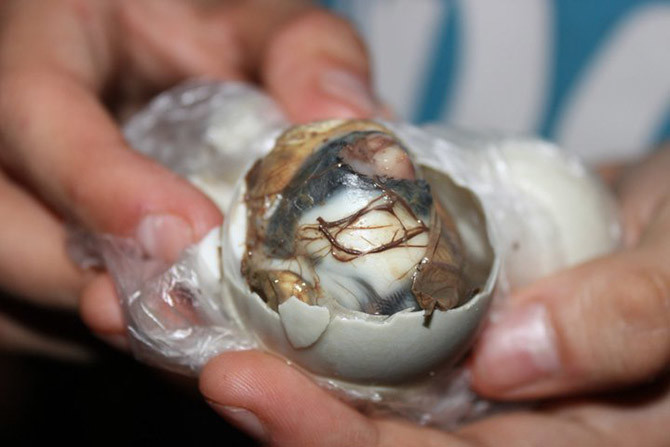I love eggs. I will eat them scrambled, fried, poached, and hard-boiled. And I will eat them at least once a week, usually more if I’m feeling ambitious on a weekday.
But when I thought about it, I actually don’t know much about eggs.
What exactly are the eggs we buy at the grocery store? Is there any way they can accidentally hatch a baby chick and I’ll be stuck raising it (I’m too young to be a mom!)? Do people eat fertilized eggs? And what exactly is the difference between white and brown eggs?
Don’t worry, I’ve got the answers.
Grocery Store Eggs Are the Product of a Chicken’s Period

Photo courtesy of Wikipedia.com
The eggs we buy at the grocery store have never been fertilized. No rooster was allowed near the hens in the making of these eggs. Or to explain it another way, eggs are the product of a chicken’s period.
Brown Eggs and White Eggs Come From Different Chickens

Photo by Carly Monado
A lot of people assume that brown eggs are tastier or more nutritious for you, or they were the product of organic/free-range chickens. They are twice as expensive as white eggs most of the time so they must be better for you, right?
The only difference between brown and white eggs is the breed of the chicken.
Brown eggs are usually the ones packaged as organic or natural which leads people to believe that brown eggs are inherently better, but quality, flavor and nutrition aren’t affected by egg color. That stuff really just comes down to the chicken and how it’s raised.
The Difference Between Free-Range, Cage-Free, and Organic Eggs

Photo courtesy of photobucket.com
How chickens are raised is a big source of contention in the animal rights world, and a huge source of confusion for consumers. After looking through some horribly graphic animal rights websites (where are my rights to be warned when you’re going to show me gory pictures?), I found a reasonably sane definition for free-range, cage-free, and organic eggs (hint: it’s mostly superficial).
We make up the health benefits of these eggs because we like to think that we are eating the products of happy chickens.
The real definition of free-range is just chickens who are allowed access to the outside for some part of the day.
Cage-free simply means they aren’t put in cages, but rather, they are in an open floor barn.
Organic is the only name that has any sort of regulation behind it. To be considered organic, chickens must be free of any sort of antibiotics and vaccines, and their feed must be free of toxins or pesticides. Organic has no bearing on how they are kept.
These labels are basically just the difference between living in the city, the suburbs, or the country. In terms of space, you are packed like a sardine in a crappy New York apartment when you are cage-free. When you’re free-range, you’ve got space but there are not a lot of places to go. Organic chickens are actually on the farm. They’re running as free as a Dixie Chick in the 90s.

GIF courtesy of youtube.com
Eggs Are Healthy (Hallelujah!)

GIF courtesy of giphy.com
Before everyone was trying to figure out the difference between free-range, natural, and hippie-raised (not a real label btw), eggs had a bad rep as the cholesterol baddies of the breakfast world. Now they are being hailed as a great source of protein and Omega 3s with very little fat content.
The protein in eggs is the highest-quality protein found in any food. It has plenty of disease fighting vitamins and brain development may be enhanced by eating eggs. Start downing those eggs people, we have brains to exercise.
People Eat Fertilized Eggs, And They Love It

Photo by Jerick Parrone
Balut is a fertilized duck egg and it is the super food of the Philippines, and is also popular in China, Laos, Cambodia, Thailand, and Vietnam. Balut is the sketchy hot dog stand item of the Asian world.
Balut eaters have carried the tradition with them as they immigrated to the US, and now you can find many businesses in California and Hawaii catering to balut eaters. There’s even a balut eating contest in New York.
While most Americans are only aware of balut as a Fear Factor or Survivor eating challenge, balut is considered a super food and a great on-the-go snack.
But why eat balut? Balut eaters supposedly regularly snack on these eggs for its aphrodisiac qualities (that’s just for the men, though) and women say they eat it for energy and its nutritional value. So it’s their hot dog and their kale.
Mostly though, it’s just a cultural thing. Many younger Filipinos admit that they are grossed out by the duck egg; it includes an actual almost-duck, beak, feathers and all. So as they assimilate, they eat more hot dogs than balut… probably.
The Egg Came Before The Chicken

Photo courtesy of funnyjunk.com
‘Nuff said.


